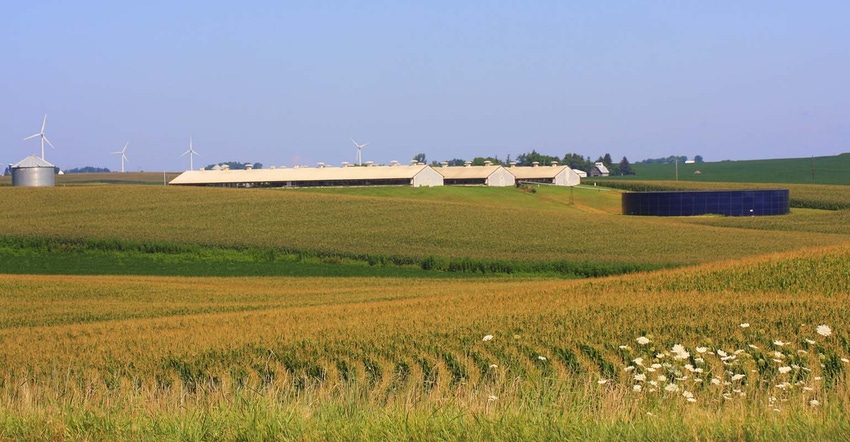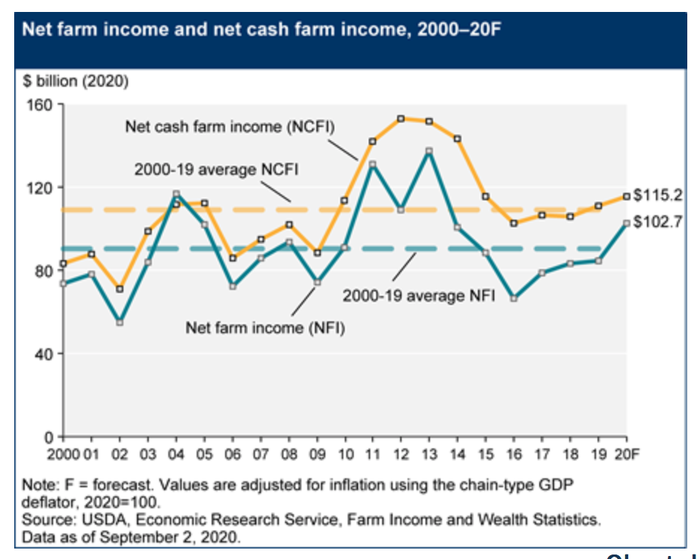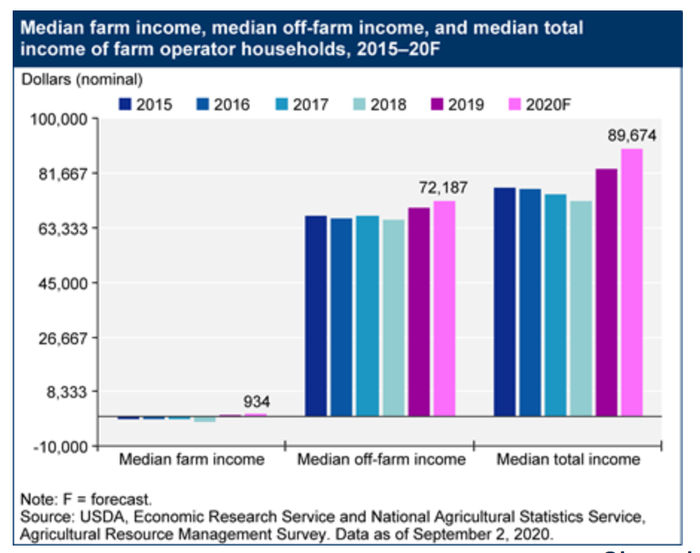September 2, 2020

Direct government farm payments are expected to increase $14.6 billion, or 64.4%, in 2020 because of supplemental and ad hoc disaster assistance payments for COVID-19 relief, according to the September 2020 Farm Income Forecast from USDA's Economic Research Service.
Other highlights from the report:
Overall inflation-adjusted U.S. net cash farm income, defined as gross cash income less cash expenses, is forecast to increase $4 billion, or 3.6%, to $115.2 billion in 2020. This would be 5.7% percent above its 2000-19 average of $109 billion. If forecast changes are realized, net cash farm income would be 5.7% above its inflation-adjusted average calculated over the 2000-19 period.
U.S. net farm income, a measure of farm sector profitability that incorporates noncash items including changes in inventories, economic depreciation, and gross imputed rental income, is forecast to increase $18.3 billion, or 21.7%, from 2019 to $102.7 billion in 2020. If realized, in inflation-adjusted terms, net farm income in 2020 would be 25.4% below its peak of $137.6 billion in 2013, but 13.8% above its 2000-19 average ($90.2 billion).

Cash receipts from farm commodities are forecast to decline $15.2 billion, or 4.1%.
Total production expenses, which are subtracted in the calculation of net income, are projected to fall $7.3 billion, or 2.1% in 2020, which is contributing to the growth in income.
Cash receipts for all commodities are forecast to decrease $12.3 billion, or 3.3%, to $358.3 billion (in nominal terms) in 2020.
Total animal/animal product receipts are expected to decrease $14.3 billion, (in nominal terms), or 8.1%, with declines in receipts for broilers, cattle/calves, hogs, and milk.
Total crop receipts are expected to increase $2 billion, (in nominal terms), or 1%, from 2019 levels.
Higher receipts for fruit/nuts are expected to more than offset lower receipts for corn, wheat, cotton, and soybeans.
Total production expenses (including operator dwelling expenses) are forecast to decrease $4.6 billion, or 1.3%, to $344.2 billion (in nominal terms) in 2020. Interest expenses and livestock/poultry purchases are expected to decrease, but fertilizer and cash labor expenses are expected to increase.
Farm business ratios
Farm business average net cash farm income is forecast to increase $3,800, or 4.8%, to $82,600 per farm in 2020. Farm businesses specializing in crops are expected to see average net cash farm income increase in 2020, while those specializing in cattle/calves, hogs, poultry, and dairy are expected to see average net cash farm income decrease in 2020.
Farm sector equity is forecast up by $18.5 billion, or 0.7% in nominal terms to $2.68 trillion in 2020. Farm assets are forecast to increase by $33.7 billion, or 1.1%, to $3.11 trillion in 2020, reflecting an anticipated 1.1% rise in farm sector real estate value.
Farm debt in nominal terms is forecast to increase by $15.2 billion, or 3.6%, to $433.8 billion, led by an expected 5.5% rise in real estate debt. The farm sector debt-to-asset ratio is expected to rise from 13.61% in 2019 to 13.95% in 2020.
Working capital, which measures the amount of cash available to fund operating expenses after paying off debt due within 12 months, is forecast to decline 12.8% from 2019.
When adjusted for inflation, farm sector equity is forecast to decline slightly in 2020, while assets and debt are forecast to increase.
Farm operator household income
Total median farm household income is forecast to increase to $83,111 in 2019 and continue to increase in 2020, reaching $89,674. In percentage terms, that is a nominal increase of 14.7%, a 12.6% increase after inflation, between 2018 and 2019 and a subsequent rise of 7.9%, a 5.9% increase after inflation, in 2020. The forecast rises in 2019 and 2020 are notable because they follow a trend from 2015 through 2018 of declining median farm household income.
Farm households typically receive income from both farm and off-farm sources. Median farm income earned by farm households is forecast to increase in 2019 to $296 from -$1,735 in 2018 and is expected to continue to increase to $934 in 2020. Median farm income earned by farm households was negative each year from 1996 to 2018. The increase in median farm income in 2019 and 2020 is largely because of increases in government payments to farm operations.
In 2019, the Market Facilitation Program provided financial assistance in response to trade disruptions. In 2020, supplemental and ad hoc disaster assistance programs—such as the Paycheck Protection Program (PPP) and Coronavirus Food Assistance Program (CFAP)—provided financial relief to those affected by the global COVID-19 pandemic.
As in previous years, many farm households rely on off-farm income. The median off-farm income is forecast to increase each year, up 6.3% to $70,000 in 2019 and up 3.1% to reach $72,187 in 2020. Like the median farm income forecast, the rise in median off-farm income is primarily because of COVID-19 relief distributed to most U.S. households through the Economic Impact Payments.

Source: USDA ERS, which is solely responsible for the information provided and is wholly owned by the source. Informa Business Media and all its subsidiaries are not responsible for any of the content contained in this information asset.
You May Also Like




